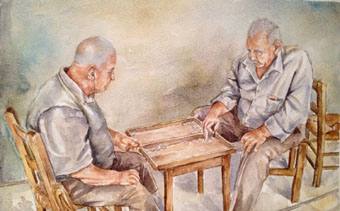|
| Magriel's NYT Columns |
 In backgammon, there is a certain breed of players eager to recount their misfortunes to anyone who will listen. Many of their hard-luck stories concern their failure to reenter from the bar in key situations.
In backgammon, there is a certain breed of players eager to recount their misfortunes to anyone who will listen. Many of their hard-luck stories concern their failure to reenter from the bar in key situations.
Curiously, the players who complain the most are often the ones that fail to take full advantage when the situation is reversed — that is, when their opponent stays out at a critical time. In such positions one needs a killer instinct to move aggressively before the opponent can recover.
In the diagrammed position, Black has hit White on the previous roll and White had failed to reenter. White is now in a vulnerable position with a man on the bar and another man exposed on the 15 point. However, White has an anchor on the 2-point and so can never be closed out completely. Accordingly, Black’s strategy is to continue to attack White and hope to gain time to scramble home while White is on the bar. If White is able to come in quickly and regroup, Black may well be at a disadvantage because White owns the cube and has superior timing.
|
| Black to play 5-2. |
The correct play is 21/16, 24/22, breaking off the 21-point in order to get a double direct shot (6’s and 1’s) at White’s blot. By immediately putting maximum pressure on White, Black gives himself the best winning chances.
Many players neglect to seriously consider this play because they are fearful of giving up the 21-point and splitting all three back men. The play, however, is necessary and involves only minimal risk. With White on the bar there is no roll (except 2-2) that really hurts Black. If White comes in and hits one of Black’s blots, White will be even further exposed and so Black will have many excellent return shots.
The diagrammed play illustrates an important type of position: you have four or five points closed in your home board and your opponent has a single man on the bar. In such a position it is essential not to worry about the good rolls your opponent has from the bar. Seize the opportunity while your opponent is out to get as much done as possible; for example, make a run for home; slot a key point in your prime; or go aggressively for a second man. Any timidity at this time is usually a major mistake because the same plays become much more dangerous after your opponent reenters.
Rollout
 Tom Keith 2013 |
|
Money play White owns 2-cube Black rolls 5-2 1296 games with VR Checker play: 2-ply Cube play: 3-ply Red |
| 5-2: | Game | G | BG | Equity | ||||
| 1 | 24/22, 21/16 |
W L |
.6319 .3681 |
.3844 .0712 |
.0287 .0038 | +0.4419 |

| |
| 2 | 24/22, 13/8 |
W L |
.6244 .3756 |
.3735 .0739 |
.0275 .0038 | +0.4111 | (0.0308) | |
| 3 | 21/14 |
W L |
.6255 .3745 |
.3722 .0770 |
.0263 .0042 | +0.4039 | (0.0380) | |
| 4 | 21/16, 13/11 |
W L |
.6144 .3856 |
.3778 .0842 |
.0282 .0052 | +0.3821 | (0.0598) | |
| 5 | 13/11, 13/8 |
W L |
.6109 .3891 |
.3670 .0789 |
.0286 .0038 | +0.3696 | (0.0723) | |
| 6 | 13/6 |
W L |
.6088 .3912 |
.3665 .0838 |
.0248 .0037 | +0.3494 | (0.0925) |

|
